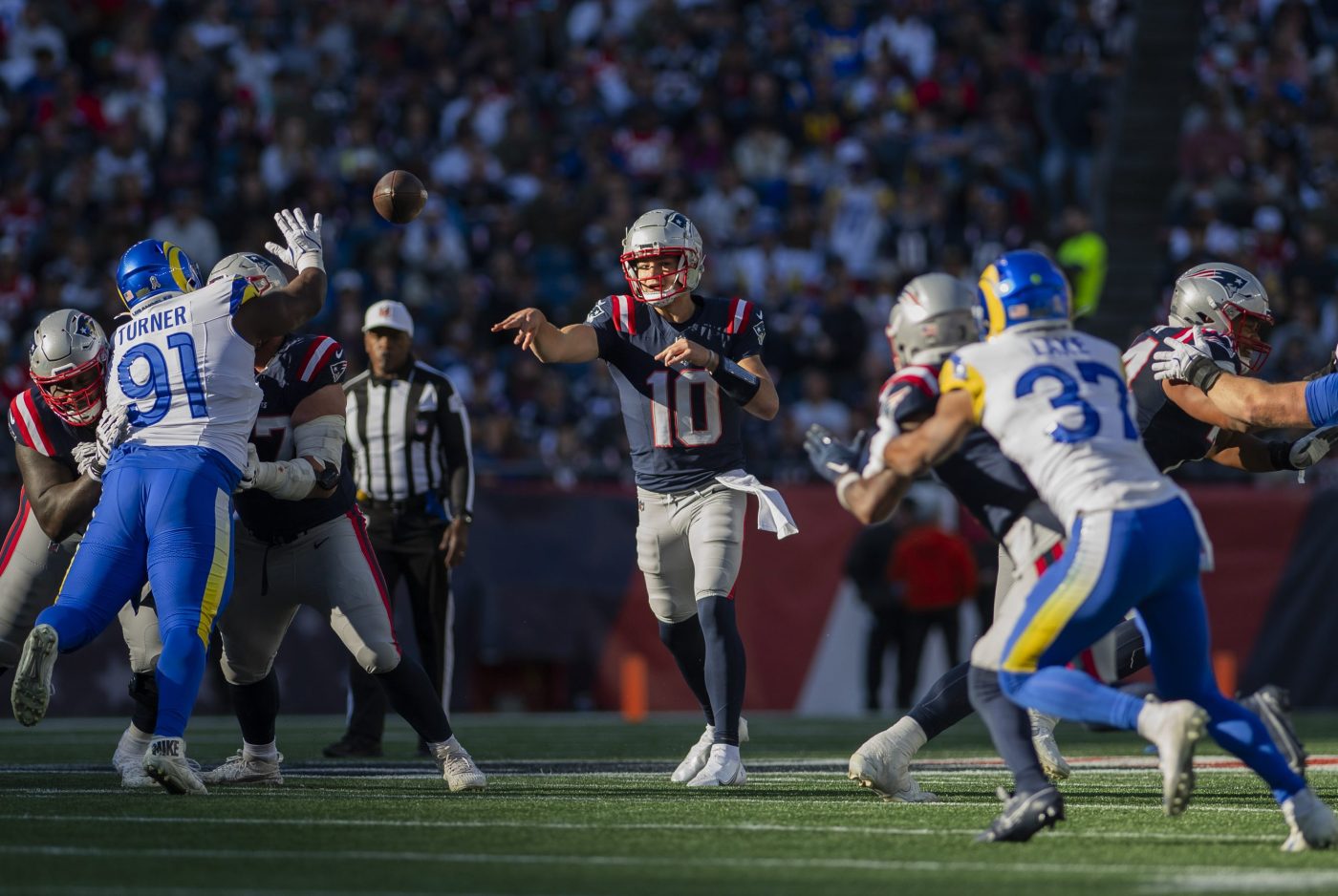
Patriots film review: Why Drake Maye’s best game wasn’t enough to beat the Rams
On Sunday, Drake Maye delivered the best performance of his young NFL career.
He played on time and created outside of structure. He threw the ball more accurately than ever before. He diagnosed blitzes and evaded pressure. And he scrambled enough to threaten the Rams, but not enough to expose himself to unnecessary hits.
Still, it wasn’t enough.
An early Maye fumble and another late interception sealed another Patriots defeat, one teammates lamented post-game as a game they should have won. Yet instead of blowing up the play that had blown their chances, the big takeaway in Foxboro was how encouraging Maye’s play had been.
Since then, after charting every snap of the Pats’ 28-22 loss, it’s clear defense and coaching were equally to blame for that defeat. How else do you explain Maye and Co. leading four scoring drives over the final 35 minutes, yet trailing the entire time?
Jerod Mayo’s overly conservative game management is one way. Rams coach Sean McVay is another.
McVay toyed with Mayo’s defense and hammered its chief, fundamental weakness: the Patriots cannot stop the pass from base personnel (four defensive backs) or stop the run from sub-packages (five defensive backs or more). When the Pats beefed up in base personnel, Los Angeles passed over the top, throwing a dozen times for 217 yards, three touchdowns and an average of 18.1 yards per play. And when the defense swapped a lineman or linebacker out for a fifth defensive back, the Rams ran over them for 6.1 yards per carry.
But worst of all, the Patriots sidelined their own strength. Following a game plan built on man-coverage and blitz pressure, star cornerback Christian Gonzalez covered Cooper Kupp or Puka Nacua on fewer than half of the Pats’ snaps in man-to-man. Instead, the coaches stuck Gonzalez on one side of the field, a tactic McVay exploited through formations and matchups to keep his two best receivers away from the Patriots’ only playmaker on defense.
That is, until Gonzalez covered Kupp on two targets during the Rams’ final drives. The results? Two harmless throws that led to two punts and let Maye try and win the game.
Here’s what else the film revealed about the Patriots’ latest loss:
Drake Maye
30-of-40 for 282 yards, 2 TDs, INT
New England Patriots quarterback Drake Maye (10) looks fo a free player to make a pass during the second half of an NFL game between the New England Patriots and the Los Angeles Rams at Gillette Stadium. (Amanda Sabga/Boston Herald)
Accurate throw percentage: 81.6%
Under pressure: 10-of-16 for 82 yards, INT
Against the blitz: 10-of-14 for 95 yards, TD, sack
Behind the line: 8-of-8 for 51 yards
0-9 yards downfield: 19-of-25 for 189 yards, TD
10-19 yards downfield: 3-of-3 for 42 yards, TD
20+ yards downfield: 0-of-2
Notes: The kid was more than all right.
Maye, under the circumstances, made a whole lot of lemonade against a defense that slowly came to strangle his running game (5.0 yards per carry in the first half, 3.2 yards allowed in the second). He carved up the middle of the field, sifting through well-timed Rams disguises and late pressure. His best throws were in-breakers to Kayshon Boutte and Kendrick Bourne, plus a late delivery to Demario Douglas for 28 yards. His patience, particularly as the Patriots continued to trail, was impressive.
Maye’s ability to throw off-platform and at different arm angles are also no longer fun luxuries. They are essentials for an offense that otherwise can’t overcome well-defended plays or generate explosives if Maye isn’t pulling the trigger or buying more time.
Critical areas
Los Angeles Rams quarterback Matthew Stafford (9) throws a pass against the New England Patriots during the first half of an NFL football game, Sunday, Nov. 17, 2024, in Foxborough, Mass. (AP Photo/Steven Senne)
Turnovers: Patriots 2, Rams 0
Explosive play rate: Patriots 5.5%, Rams 11.7%
Success rate: Patriots 58.9%, Rams 58.8%
Red-zone efficiency: Patriots 2-5, Rams 3-4
Defensive pressure rate: Patriots 22.2%, Rams 41.6%
Offense
Game plan
New England Patriots head coach Jerod Mayo, left, looks on during the first half of an NFL game between the New England Patriots and the Los Angeles Rams at Gillette Stadium. (Amanda Sabga/Boston Herald)
Personnel breakdown: 55% of snaps in 11 personnel, 40% snaps in 12 personnel, 2.5% snaps in 13 personnel, 2.5% snaps in 21 personnel.***
Personnel production: 57.5% success rate in 11 personnel, 69% success rate in 12 personnel, 0% success rate in 13 personnel, 0% success rate in 21 personnel.
First-down down play-calls: 54.5% pass (66% success rate), 45.5% run (66% success rate)
Play-action rate: 23.8%
Offensive coordinator Alex Van Pelt opened with a pass-happy plan, throwing on 11 of the offense’s first 15 plays, including four straight first-down snaps to start. The Pats prioritized the middle of the field, feeding 15 combined targets to DeMario Douglas and tight ends Hunter Henry and Austin Hooper. Van Pelt also fed Maye a steady diet of blitz-beaters to offset the Rams’ variety of pressure schemes, including a 14-yard bubble screen to Douglas and different shallow cross concepts.
Los Angeles created more problems for the Pats’ pass protection than most teams, unlocking four unblocked pressures. But more often than not, Maye nullified that pressure with his legs, a short throw or a throwaway.
As for Van Pelt, his play-calling grew more conservative late, especially over the penultimate drive that featured several runs, lasted 6:09 and finished in a field goal; an effort likely to keep pressure off Maye and maintain steady gains. He also didn’t have many answers once the Rams got ahold of his run game.
But statistically, this was the Pats’ best offensive performance yet, a byproduct of improved quarterback play and coaching. And the touchdown pass to an offensive lineman? Nice touch.
Player stats
New England Patriots running back Rhamondre Stevenson (38) looks fo a way through the defense during the second half of an NFL game between the New England Patriots and the Los Angeles Rams at Gillette Stadium. (Amanda Sabga/Boston Herald)
Broken tackles: RB Rhamondre Stevenson 3, RB Antonio Gibson, WR DeMario Douglas, WR Kendrick Bourne, WR Kayshon Boutte
Pressure allowed: Team 5 (3 QB hits, 2 hurries), RT Demontrey Jacobs 4 (sack, 3 hurries), LT Vederian Lowe 3 (sack, 2 hurries), C Ben Brown (sack, QB hit, hurry), QB Drake Maye 2 (QB hit, hurry), RG Mike Onwenu (hurry), Stevenson (hurry)
Run-stuffs allowed: TE Hunter Henry 2, Team 2
Drops: Boutte
Notes
After 11 games, the Patriots seem to have properly calibrated their passing distribution, with Hunter Henry and DeMario Douglas ranking among the team leaders in targets for another week.
Henry and Douglas are the Patriots’ most reliable weapons, and, in Douglas’ case, best yards-after-catch threat.
Kendrick Bourne’s bounce-back, 70-yard performance overshadowed another disappointing day from the receivers. The Rams entered with a below-average secondary that only Bourne and Douglas ultimately exploited.
Bourne has clear chemistry with Maye, considering the when and how of his targets: critical situations (two-minute drill and the red zone) and low-percentage nature of certain targets. He also finished with more yards than the rest of the other receivers combined.
Rookies Ja’Lynn Polk (31 snaps) and Javon Baker (5) finished without a target between them. Polk’s false start penalty on fourth-and-1 would have been worse, were it not for the play clock hitting zero at the time he jumped.
Polk’s struggles have forced the Patriots into a hard decision of whether to continue to hand him snaps in the hopes that he develops or prioritize winning with Bourne, Douglas and Kayshon Boutte.
Boutte remains a steady, adequate option outside at the “X” receiver spot where he’s asked often to win in isolation. His best route remains the slant, where Maye hit him to beat a blitz at the start of their last scoring drive. His downfield targets have been more miss than hit lately.
At running back, Rhamondre Stevenson and Antonio Gibson looked more interchangeable than usual. Stevenson’s make-or-miss ability has waned the last three weeks, with just seven combined broken tackles; the same total he had in a win over the Jets on Oct. 29.
More pass-protection struggles at offensive tackle. Vederian Lowe allowed three pressures for a second straight week, while Demontrey Jacobs faltered late and led the team with four.
Left guard Michael Jordan was the only O-lineman to escape with a clean sheet, but defenses continue to attack him and center Ben Brown with twists and stunts.
Defense
New England Patriots cornerback Christian Gonzalez (0) during the second half of an NFL football game, Sunday, Nov. 17, 2024, in Foxborough, Mass. (AP Photo/Michael Dwyer)
Game plan
Personnel breakdown: 43% base defense, 27% three-corner nickel package, 20% dime, 8% three-safety nickel, 2% quarter.****
Coverage breakdown: 59% man, 41%
Blitz rate: 59.3%
Blitz efficacy: 50% offensive success rate and 10.9 yards per play allowed
A head-scratcher.
Jacking up their blitz rate against an injured offensive line with some of the worst pass-protecting metrics in football was one thing. (Stafford has a 97.1 passer rating versus the blitz this season, and why not rush four?) But refusing to weaponize Christian Gonzalez in a full- or part-time shadow versus one of the Rams’ only two weapons was hard to understand.
Instead, the Patriots kept Gonzalez in the boundary, or short side of the field, which allowed McVay to dictate matchups. And that he did, repeatedly parking his tight ends across from Gonzalez and throwing away from him. In zone, that left Cooper Kupp working against a lesser defensive back or sometimes open space. Kupp beat rookie safety Dell Pettus on his first touchdown.
The #Patriots played man-to-man on 16 of LA’s 27 dropbacks. Christian Gonzalez covered Cooper Kupp or Puka Nacua on 7/16.
Rams’ passing with Gonzo on Kupp/Puka: 4/7, 36 yards, 33% success rate
Rams’ passing with Gonzo on other WRs: 6/9, 146 yards, 3 TDs, 66% success rate https://t.co/RjcGlH7vDo pic.twitter.com/ua3GYuB6Gl
— Andrew Callahan (@_AndrewCallahan) November 18, 2024
In man, Gonzalez saw more of Kupp in the second half, but still remained stuck in the boundary. When Gonzalez wasn’t covering Kupp or Puka Nacua during snaps of man-to-man, the Rams averaged 16.2 yards per attempt. When Gonzalez did cover one of them in man-to-man, those snaps yielded 5.1 yards per attempt for Los Angeles.
The Patriots, rightfully, seemed preoccupied with McVay’s variety of pre-snap motions, bunch sets and man-beating route concepts that create trouble for defenders covering 1-on-1 (recently released corner Marco Wilson was involved in a few communication busts). But they strayed too far away from their core belief of neutralizing the opponent’s strength, and instead got outwitted and outmuscled in their own stadium. Oh, and no double teams? Not a one?
Player stats
New England Patriots defensive tackle Christian Barmore (90) during the second half of an NFL football game against the Los Angeles Rams, Sunday, Nov. 17, 2024, in Foxborough, Mass. (AP Photo/Michael Dwyer)
Pressure: LB Christian Elliss 2 (QB hit, hurry), DL Keion White (QB hit), OLB Anfernee Jennings (QB hit), CB Christian Gonzalez (QB hit), S Dell Pettus (hurry)
Run stuffs: Team 2
Pass deflections: DB Jonathan Jones, White
Missed tackles: S Kyle Dugger 3, LB Christian Elliss 2, DB Marcus Jones, DL Jeremiah Pharms Jr.
Notes
Welcome back, Christian Barmore. The young defensive tackle played 21 snaps in his season debut, most as a pass-rusher. Barmore finished with just three tackles and zero pressures, but taking the field was a win by itself after this summer’s blood clots diagnosis.
Barmore’s return aside, there were no wins for the Patriots’ pass rush. They recorded zero hurries, hits or sacks without blitzing. Linebacker Christian Elliss, who struggled in run defense and coverage, was the only Patriot to tally multiple pressures.
Of the Patriots’ seven pressures, two belonged to defensive backs who rushed through the offensive line unblocked. Christian Gonzalez earned one on a third-down blitz, a curious call given, again, Gonzalez represented the Patriots’ best weapon in coverage against Kupp and Nacua.
Brutal day for Jonathan Jones. Nacua beat the veteran corner for a diving touchdown in the first half, then Kupp roasted him during a rare all-out blitz in the third quarter. Overall, he gave up three catches, most on the team.
Credit is owed to Rams quarterback Matthew Stafford for beating pressure on both throws, but there was a reason he picked on Jones throughout the game, including his last dropback.
One note on that play: whether by original design or a pre-snap check called by safety Jaylinn Hawkins, the Patriots double-teamed Rams receiver Demarcus Robinson on Stafford’s final throw (a deep sideline incompletion to Nacua). Meanwhile, Kupp and Nacua were single-covered after breaking from a bunch set. Hard to understand why.
Hawkins doubled Robinson with Marcus Jones, who allowed two catches, including a key third-down grab to Nacua. The size and strength mismatch presented to the 5-foot-8 Jones made it all the more curious why Gonzalez didn’t see more of Nacua, and instead covered Kupp late in the game on third downs.
New pass-rusher Yannick Ngakoue played 14 snaps, including 11 against the pass, and came inches shy of a hurry in the red zone.
Veteran safety Kyle Dugger, back from a three-game absence due to an ankle injury, looked rusty. His three tackles matched his three misses.
Special teams
Foxboro, MA – New England Patriots’ Mike Onwenu pats Joey Slye on the helmet after a missed field goal during the 2nd quarter of the game at Gillette Stadium . (Nancy Lane/Boston Herald)
The blocked extra point in the fourth quarter had dire consequences in that it kept the Patriots trailing by two possessions with less than 13 minutes left. Rams linebacker Michael Hoecht split offensive linemen Demontrey Jacobs and Lecitus Smith on the play.
Jerod Mayo’s reluctance to try a 54-yard field goal in the first half may have been affected by Joey Slye’s shaky warmup kicks toward that end of the stadium. However, flags at the top of the stadium were blowing toward the field goal post, which may have helped Slye get a little extra oomph on his attempt.
The Pats yanked rookie receiver Javon Baker off kick return in the second half, replacing him with running back JaMycal Hasty. Baker did not execute to the coaches’ liking, according to Mayo; a bad sign.
Punter Bryce Baringer dropped one of two punts inside the Rams’ 20-yard line, and had the other go for a touchback. His counterpart, Rams punter Ethan Evans, pinned the Patriots three times and rendered stud returner Marcus Jones a non-factor.
Studs
New England Patriots wide receiver Kendrick Bourne (84) is dragged down in the ends zone by Los Angeles Rams cornerback Ahkello Witherspoon (4) during the first half of an NFL game between the New England Patriots and the Los Angeles Rams at Gillette Stadium. (Amanda Sabga/Boston Herald)
WR Kendrick Bourne
He caught all five targets and doubled his season total for receiving yards with a team-high 70 Sunday. Bourne also caught a touchdown and the first pass of the game.
QB Drake Maye
He’s creating outside of structure, adjusting to pressure within plays. The kid is a natural.
Duds
Coaching
Related Articles
Patriots activating cornerback off injured reserve to fill 53-man roster.
Source: Patriots waiving veteran cornerback, opening door for defender’s return
How Jerod Mayo assessed two season debuts from Patriots defenders
Patriots have a tough decision to make on rookie wide receivers
Patriots HC Jerod Mayo believes report about Krafts, Drake Maye’s development are false
Jerod Mayo’s in-game decisions — twice passing up short fourth-down conversions for field goals and a 2-point conversion while trailing by nine — were questionable at best. But overseeing a defense that failed to adjust and got killed by the two players the Patriots had to stop was inexcusable.
Pass rush
Facing a below-average offensive line, the Pats failed to generate a single pressure without blitzing.
CB Jonathan Jones
Jones allowed two touchdowns, including a 69-yarder to Cooper Kupp in the third quarter. This was Jones’ worst game of the season and maybe in years.
*Explosive plays are defined as runs of 12-plus yards and passes of 20-plus yards.
**Success rate is an efficiency metric measuring how often an offense stays on schedule. A play is successful when it gains at least 40% of yards-to-go on first down, 60% of yards-to-go on second down and 100% of yards-to-go on third or fourth down.
***11 personnel = one running back, one tight end; 12 personnel = one running back, two tight ends; 13 personnel = one running back, three tight ends; 21 = two halfbacks, one tight end.
****Base defense = four defensive backs; nickel = five; dime = six; quarter = seven.


